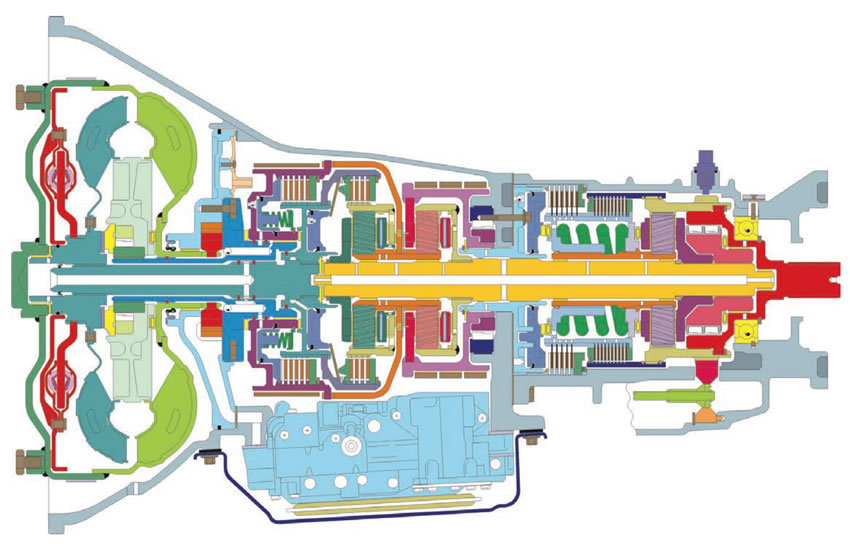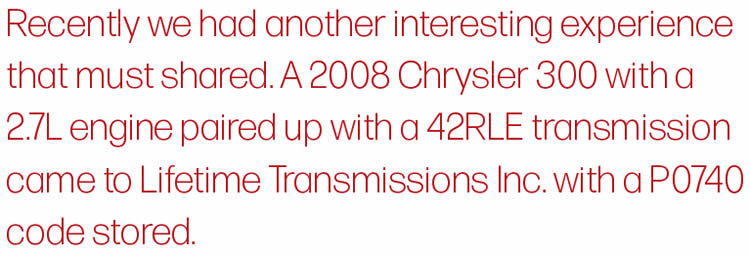
Technically Speaking
- Author: Wayne Colonna, Technical Editor
- Subject: 42RE
- Issue: Air Conditioning
The past 28 years of being involved with ATSG’s technical help line has been a continuous learning experience. Particularly when a problem is resolved outside the parameters of what would normally fix the problem.

For example; several years back Lorenzo Ortiz from Phillips transmission had a 2003 Jeep Grand Cherokee 4.0L 4×4 with a 42RE come into the shop for transmission repair. After installing a rebuilt transmission, the vehicle exhibits a misfire. This was not a problem before transmission repairs. Upon inspection, the vehicle has stored a P0352 code for an ignition coil #2 primary circuit fault.

Diagnostics related to this code were performed but no circuit problems were found. After much time and money was poured into this vehicle in an attempt to resolve the problem, frustration lead to a sudden punch on the accelerator. This produced a crank sensor code which lead to discovering that is was slightly out of adjustment. Once it was properly adjusted with the correct air gap, the P0352 code was also eliminated. When O. E. information is looked at for possible reason to have P0352 set, a misadjusted crank sensor is not one of them.
This is just one such example that has been seen over the years here at ATSG. Recently we had another interesting experience that must shared. A 2008 Chrysler 300 with a 2.7L engine paired up with a 42RLE transmission came to Lifetime Transmissions Inc. with a P0740 code stored. Chrysler defines this code as a converter clutch apply out of range. Chrysler provides the following information about this code:

Theory of Operation: When in 2nd, 3rd, or 4th gear, the Torque Converter Clutch (TCC) can be locked (FEMCC) or partially locked (PEMCC) when certain conditions are met. The TCC piston is electronically modulated by increasing the duty cycle of the LR/TCC solenoid until the torque converter slip difference (difference between engine and turbine speed) is within 60 rpm. Then the LR/TCC solenoid is fully energized (FEMCC / 100% duty cycle). Torque converter slip is monitored in FEMCC to ensure adequate clutch capacity. The transmission will attempt normal EMCC operation (not in limp-in) even after the MIL is illuminated. MIL will illuminate after five minutes of accumulated slip in FEMCC.
When Monitored: The Torque Converter Clutch (TCC) is in FEMCC or PEMCC, Transmission temperature is hot, Engine temperature is greater than 38°C or 100°F, Transmission Input Speed greater than engine speed, TPS less than 30°, and brake not applied.
Set Condition: The TCC is modulated by controlling the duty cycle of the L/R Solenoid until the difference between the Engine rpm and the Transmission Input Speed rpm or duty cycle is within a desired range. The DTC is set after the period of 10 seconds and three occurrences of either: FEMCC – with slip greater than 100 rpm or PEMCC – duty cycle greater than 85%.
Possible Causes: LR/TCC Solenoid malfunction or Internal Transmission failure.
Great information about how it works, when it is being monitored and the conditions that would set the code. But when it comes to causes, not too much is offered.
Wayne Scherado diagnosing this problem was not too eager to jump into the transmission as he noticed the P0740 code would set only when the AC was on. He decided to hire an automotive trainer that has his expertise with drivability concerns to take a close look at the vehicle. After doing so he said, “I am not a transmission expert but I think the AC needs to be looked at”. He showed Wayne the graphs of when the AC was off. TCC slip was between 20 and 60 rpms. But when the AC was on, slip would run up as high as 130 rpms.
What was also of interest is that the AC would cycle on and off. When the code was erased, during a few cycles of the AC coming on and off, rpm slip would go up and down in sync with the AC turning on and off.

When they put gauges on the AC system, they saw the Hi side was over 300 psi and low side was over 140 psi. Upon seeing these high pressures, they decided to evacuate and recharge the system. Once this was done, the problem was solved. They also noticed that the AC no longer cycled on and off which seems to suggest that there is some type of software written into the system to do this when it sees high AC pressure. In speaking with the owner of the vehicle, his regular auto mechanic mentioned to him that his AC was low. The owner gave him the go ahead to charge the AC system.
Being in Oklahoma, he didn’t need the AC until he took a trip to Arizona. It was then that he used the AC and experienced the TCC cycling on and off followed by the illumination of the MIL. The vehicle was delivered to the owner after the repair and a follow up phone call was made weeks later verifying the problem was resolved. It’s good to know that with some vehicles, an overcharged AC can cause P0740 to set.














